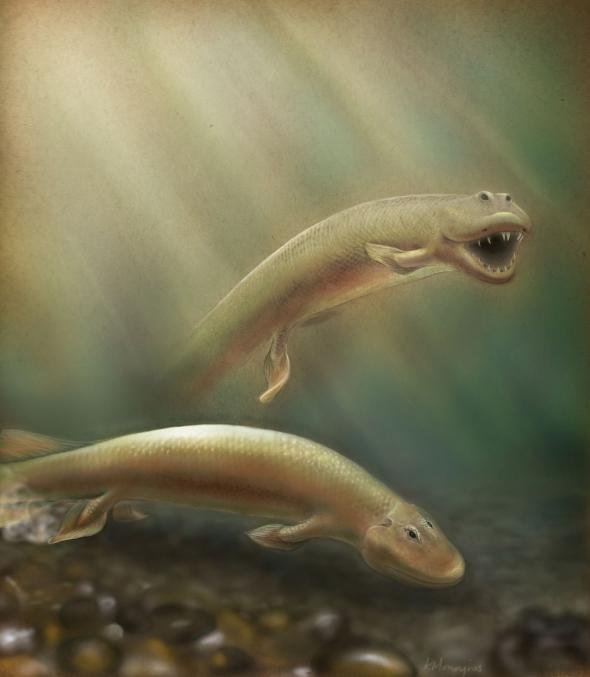Tiktaalik Roseae: A 375-Million-Year-Old Fish Had Fins For Walking
MessageToEagle.com – Tiktaalik Roseae was a 375-million-year-old crocodile-like fish that could grow up to nine feet in length and hunted in shallow freshwater environments. What is extraordinary about this animal is that the fish had fins for walking. Tiktaalik Roseae, better known as the “fishapod it is the best representation of transitional species between fish and land-dwelling tetrapods.
Tiktaalik means “large, freshwater fish” in the language of the Nunavut people, who live in the region near its discovery site on Canada’s frigid Ellesmere Island.
Tiktaalik Roseae lived in marshy river settings resembling today’s Amazon.
A series of discoveries, including Tiktaalik and similar creatures over the past decade, are giving scholars opportunity to learn when animals, other than insects first made the leap to land.

ILLUSTRATION BY KALLIOPI MONOYIOS
Why fish made the move to land 395 million years ago remains a bit of a mystery. It was very long time ago the ancient supercontinent of Gondwana was drifting toward the proto-North American continent.
See also: Pristimantis Mutabilis: Shape-Shifting Frog In The Ecuadorian Cloud Forest
During this drift created many shallow-water habitats, hence perfect places for something crocodile-like to thrive. These environments were also at the equator at that time, so it is nice and warm and tropical.
The problem was food. But there was not much to eat on land at the time for Tiktaalik, aside from spiders, scorpions, insects, and a few plants. Fewer predators or a safer place to lay eggs may have instead driven land creatures to evolve, some suggest.
MessageToEagle.com
Related Posts
-
 Vredefort Crater Is The Largest And Oldest Impact Crater On Earth
No Comments | Jan 20, 2016
Vredefort Crater Is The Largest And Oldest Impact Crater On Earth
No Comments | Jan 20, 2016 -
 Ancient ‘Yahweh And His Asherah’ Inscriptions At Kuntillet ‘Ajrud Remain An Unsolved Biblical Mystery
No Comments | Apr 12, 2017
Ancient ‘Yahweh And His Asherah’ Inscriptions At Kuntillet ‘Ajrud Remain An Unsolved Biblical Mystery
No Comments | Apr 12, 2017 -
 Marine Creatures You’d Better Stay Away From
No Comments | Feb 5, 2016
Marine Creatures You’d Better Stay Away From
No Comments | Feb 5, 2016 -
 Do Our Laws Of Physics Apply In A Holographic Universe? Scientists Unravel The Secrets Of The Universe
No Comments | Nov 21, 2015
Do Our Laws Of Physics Apply In A Holographic Universe? Scientists Unravel The Secrets Of The Universe
No Comments | Nov 21, 2015 -
![The Second Triumvirate was legally established for reestablishing the public welfare] in 43 BC for five years; it was renewed in 37 BC The members were Octavian (Augustus), Marc Antony, and Marcus Aemilius Lepidus (d.13 BC).](https://www.messagetoeagle.com/wp-content/uploads/2016/02/Triumvirate12-307x150.jpg) What Was A ‘Triumvirate’ In Ancient Rome?
No Comments | Feb 15, 2016
What Was A ‘Triumvirate’ In Ancient Rome?
No Comments | Feb 15, 2016 -
 The Bayeux Tapestry: One Of The Great Historical Records Of The Middle Ages
No Comments | Feb 29, 2016
The Bayeux Tapestry: One Of The Great Historical Records Of The Middle Ages
No Comments | Feb 29, 2016 -
 Is There Anything I Can Do To Keep My Brain Healthy In Older Age?
No Comments | Feb 14, 2016
Is There Anything I Can Do To Keep My Brain Healthy In Older Age?
No Comments | Feb 14, 2016 -
 Francesco Lentini: The Three-Legged Wonder Man With Four Feet And 16 Toes Who Became A Celebrity
No Comments | Feb 24, 2017
Francesco Lentini: The Three-Legged Wonder Man With Four Feet And 16 Toes Who Became A Celebrity
No Comments | Feb 24, 2017 -
 What Is Causing Mexico City To Sink?
No Comments | Dec 3, 2016
What Is Causing Mexico City To Sink?
No Comments | Dec 3, 2016 -
 Legendary Helike – Uncovering Lost City of Poseidon
No Comments | Sep 28, 2015
Legendary Helike – Uncovering Lost City of Poseidon
No Comments | Sep 28, 2015
